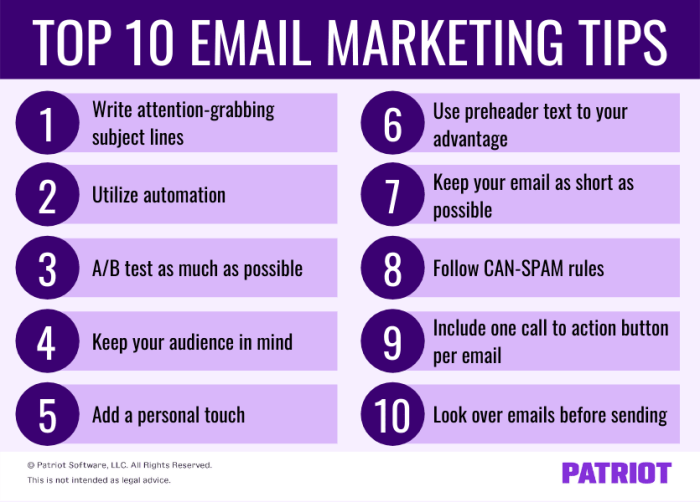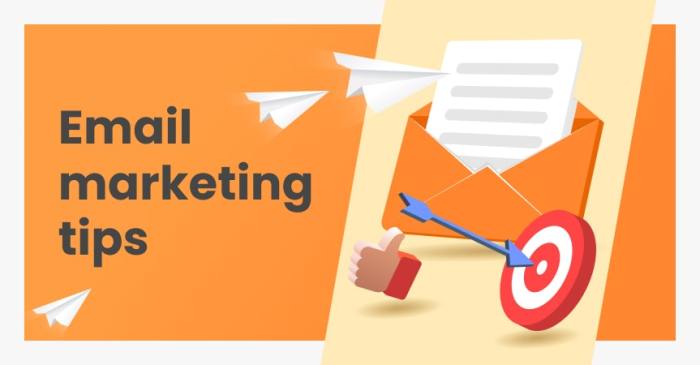Email Marketing Tips takes center stage in the digital marketing world, offering businesses a powerful tool to engage with their audience. From building an email list to crafting compelling content, this guide will help you master the art of email marketing with finesse and style.
Get ready to elevate your email marketing game and drive success like never before.
Importance of Email Marketing
Email marketing is a crucial strategy for businesses as it allows direct communication with customers, helps in building relationships, and drives conversions. With a well-crafted email campaign, businesses can reach a targeted audience, personalize messages, and track performance metrics to optimize results.
Examples of Successful Email Marketing Campaigns
- Starbucks: The coffee giant sends personalized offers and rewards to their loyalty program members, leading to increased customer engagement and sales.
- Dollar Shave Club: This subscription-based service uses witty and entertaining content in their emails, resulting in high open and click-through rates.
- Airbnb: Airbnb sends personalized recommendations and travel tips based on user preferences, enhancing the overall customer experience.
Statistics on the Effectiveness of Email Marketing
- According to DMA, email marketing has an average ROI of $42 for every $1 spent, making it a highly cost-effective marketing channel.
- A study by HubSpot found that 59% of marketers consider email to be their most effective channel in terms of revenue generation.
- Data from Statista shows that the number of global email users is expected to reach 4.48 billion by 2024, indicating the wide reach and potential of email marketing.
Building an Email List

Building an email list is crucial for any successful email marketing campaign. It involves strategically growing your list of subscribers and engaging with them effectively. Here are some key strategies to consider:
Organic Growth Methods
- Opt-in Forms: Place opt-in forms on your website, blog, and social media platforms to encourage visitors to subscribe to your emails.
- Content Upgrades: Offer exclusive content upgrades, such as ebooks, guides, or templates, in exchange for email sign-ups.
- Webinars and Events: Host webinars or events and require attendees to provide their email addresses to register.
Segmenting Email Lists
Segmenting your email lists involves dividing your subscribers into different groups based on their interests, demographics, or behaviors. This allows for more targeted and personalized email campaigns, leading to higher engagement and conversion rates.
By segmenting your email lists, you can send more relevant content to each subscriber, increasing the likelihood of them taking action.
Creating Lead Magnets
- Ebooks and Guides: Offer free downloadable ebooks or guides that provide valuable information to your target audience.
- Checklists and Templates: Create helpful checklists or templates that can assist your subscribers in achieving their goals.
- Exclusive Discounts: Provide exclusive discounts or offers to subscribers who sign up for your email list.
Crafting Compelling Email Content
Crafting compelling email content is crucial for grabbing the attention of your subscribers and driving engagement. From catchy subject lines to personalized content and visually appealing designs, there are several key elements to consider when creating emails that stand out in crowded inboxes.
Writing Engaging Subject Lines, Email Marketing Tips
Subject lines are the first thing recipients see when they receive your email, so it’s essential to make them attention-grabbing and compelling. Here are some guidelines for writing engaging subject lines:
- Keep it concise and to the point
- Use action-oriented language to inspire recipients to open the email
- Incorporate personalization by including the recipient’s name or other relevant information
- Create a sense of urgency or exclusivity to encourage immediate action
Importance of Personalization in Email Content
Personalization plays a crucial role in email marketing by making recipients feel valued and understood. Here are some tips for incorporating personalization in your email content:
- Address recipients by their name
- Segment your email list to deliver more targeted content based on preferences or past interactions
- Include dynamic content that adapts based on recipient behavior or demographics
Creating Visually Appealing and Mobile-Responsive Emails
In a world where most people check their emails on mobile devices, it’s essential to ensure your emails are visually appealing and optimized for mobile responsiveness. Here are some tips for creating visually appealing and mobile-responsive emails:
- Use a clean and simple design with eye-catching visuals
- Optimize images for quick loading on mobile devices
- Keep your email copy concise and easy to read on smaller screens
- Test your emails on different devices to ensure they display correctly
Email Automation

Email automation is a powerful tool in marketing campaigns that allows businesses to send targeted, personalized messages to their customers automatically. By setting up automated workflows, companies can save time, increase efficiency, and deliver timely and relevant content to their audience.
Types of Automated Email Campaigns
- Welcome Series: Introduce new subscribers to your brand, products, and services through a series of automated emails that nurture the relationship from the start.
- Abandoned Cart Emails: Remind customers who have left items in their shopping cart to complete their purchase, increasing the chances of conversion.
- Re-engagement Campaigns: Reach out to inactive subscribers to rekindle their interest in your brand and encourage them to engage with your content again.
Best Practices for Setting Up Effective Email Automation Workflows
- Segment Your Audience: Divide your email list into groups based on demographics, behavior, or preferences to send more targeted and relevant messages.
- Personalize Your Content: Use customer data to personalize emails with relevant recommendations, product suggestions, or tailored offers.
- Set Clear Goals: Define the objectives of your automated campaigns, whether it’s driving sales, increasing engagement, or boosting brand loyalty.
- Monitor and Analyze Performance: Track key metrics such as open rates, click-through rates, and conversions to optimize your automated workflows for better results.
Measuring Email Marketing Success: Email Marketing Tips
In the world of email marketing, success is measured by various key metrics that help businesses understand the effectiveness of their campaigns. By tracking metrics such as open rates, click-through rates, and conversion rates, marketers can gain valuable insights into the performance of their email marketing efforts.
Key Metrics to Track
- Open Rates: This metric indicates the percentage of recipients who opened the email. A high open rate suggests that the subject line and sender name were compelling enough to grab the recipient’s attention.
- Click-Through Rates: The click-through rate measures the percentage of recipients who clicked on a link within the email. It shows how engaging the content was and if it prompted action from the recipient.
- Conversion Rates: Conversion rates track the percentage of recipients who completed a desired action, such as making a purchase or signing up for a webinar, after clicking on a link in the email. This metric directly ties email marketing efforts to business goals.
Analyzing Performance
- When analyzing email open rates, consider experimenting with different subject lines to see what resonates best with your audience. Personalization and relevance are key factors that can impact open rates.
- For click-through rates, pay attention to the placement of links within the email, as well as the overall design and call-to-action. Testing different layouts and CTAs can help optimize click-through rates.
- To improve conversion rates, focus on creating a clear and compelling message that drives recipients to take action. A/B testing different offers or incentives can also help identify what resonates best with your audience.
Tips for A/B Testing
- When conducting A/B tests, make sure to test only one element at a time to accurately measure its impact on performance. This could include testing different subject lines, email content, CTAs, or send times.
- Set clear goals for your A/B tests and track the results rigorously to determine which variation is more successful. Use the insights gained from testing to continuously refine and optimize your email marketing strategies.
